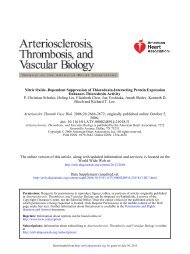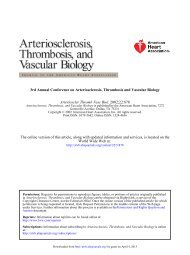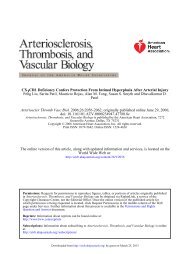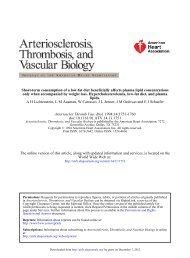Smooth Muscle Cells in Atherosclerosis Originate - Arteriosclerosis ...
Smooth Muscle Cells in Atherosclerosis Originate - Arteriosclerosis ...
Smooth Muscle Cells in Atherosclerosis Originate - Arteriosclerosis ...
Create successful ePaper yourself
Turn your PDF publications into a flip-book with our unique Google optimized e-Paper software.
plaques from the control apoE / and eGFP apoE / male<br />
mice (n22, 32 weeks of age, 48 of 94 analyzed nucleated<br />
SMA cells) and <strong>in</strong> the range predicted from the thickness<br />
of the section and the nuclear size.<br />
SMCs Are Derived From the Local Vessel Wall <strong>in</strong><br />
Cross-Grafted Arterial Segments<br />
Our observations <strong>in</strong> BM-transplanted mice showed that differentiation<br />
of hematopoietic stem cells to plaque SMCs is<br />
exceed<strong>in</strong>gly rare if it occurs at all. To evaluate whether<br />
circulat<strong>in</strong>g smooth muscle progenitor cells of nonhematopoietic<br />
orig<strong>in</strong> can contribute to atherosclerotic plaque SMCs, we<br />
then analyzed SMC orig<strong>in</strong> <strong>in</strong> atherosclerotic lesions that were<br />
<strong>in</strong>duced proximal to a constrictive collar <strong>in</strong> cross-grafted<br />
CCA segments (Figures 1b and 5a).<br />
Of 20 mice <strong>in</strong> which we performed CCA segment transplantations<br />
and collar placements, complete or near-complete<br />
Bentzon et al Orig<strong>in</strong> of SMCs <strong>in</strong> <strong>Atherosclerosis</strong> <strong>in</strong> ApoE / Mice 2699<br />
Downloaded from<br />
http://atvb.ahajournals.org/ by guest on June 4, 2013<br />
Figure 3. Hematopoietic stem cells do not contribute<br />
to plaque SMCs. a, Overview of aortic root<br />
plaque from eGFP apoE / BM 3 apoE / transplanted<br />
mouse (32 weeks of age) exhibit<strong>in</strong>g donorderived<br />
eGFP foam cells (green) and the formation<br />
of a fibrous cap of recipient-derived SMA <br />
cells (red only). L <strong>in</strong>dicates lumen; C, fibrous cap;<br />
F, foam cells; M, tunica media; A, tunica adventitia.<br />
Scale bar200 m. b, Higher magnification of the<br />
area demarcated <strong>in</strong> a. Fluorescence microscopy<br />
comb<strong>in</strong>ed with DIC imag<strong>in</strong>g (gray scale) to reveal<br />
tissue structure. Scale bar50 m. c-e, Further<br />
analysis of the area demarcated <strong>in</strong> b. With the<br />
superimposed DIC image, it is often possible to<br />
visualize cell boundaries that would otherwise<br />
escape detection by fluorescence microscopy.<br />
Arrows <strong>in</strong>dicate two separate cellular structures<br />
appear<strong>in</strong>g as depressions <strong>in</strong> the relief-like DIC<br />
image (c), one of which sta<strong>in</strong>s positive for SMA <br />
(d, red channel). The neighbor<strong>in</strong>g cell is eGFP (e,<br />
red and green channels). No eGFP SMA <br />
double-positive cells are present. Scale<br />
bar25 m.<br />
graft occlusions were present <strong>in</strong> 5 mice at time of sacrifice. In<br />
4 mice, no significant lesions were found, and <strong>in</strong> 2 mice,<br />
extensive lesion formation extend<strong>in</strong>g <strong>in</strong>to the graft from the<br />
proximal anastomosis was present. These were all excluded<br />
from the analysis. Most likely, the cause of these technical<br />
failures was <strong>in</strong>consistency <strong>in</strong> tighten<strong>in</strong>g of the ligature around<br />
the collar to yield appropriate constriction. None of the<br />
CCA-transplanted mice <strong>in</strong> which no collar was placed developed<br />
lesions <strong>in</strong> the grafted artery apart from a small mural<br />
thrombus <strong>in</strong> one.<br />
In all other mice, advanced plaques had developed focally<br />
immediately proximal to the constrictive collar with an area<br />
of unaffected vessel wall separat<strong>in</strong>g the lesion from the<br />
proximal anastomosis site (Figure 5b). In plaques that had<br />
formed <strong>in</strong> apoE / artery segments grafted <strong>in</strong>to<br />
eGFP apoE / mice (n4), not a s<strong>in</strong>gle eGFP SMA cell<br />
Figure 4. Sequential immunosta<strong>in</strong><strong>in</strong>g and FISH<br />
technique revealed no male SMA cells <strong>in</strong><br />
plaques <strong>in</strong> male eGFP apoE / BM 3 female<br />
apoE / transplanted mice. The figure shows analysis<br />
of an aortic root plaque from a mouse 20<br />
weeks of age. a, SMA immunosta<strong>in</strong>ed sections<br />
were analyzed and the digitized images were<br />
stored. Deconvoluted optical section is shown.<br />
Arrows <strong>in</strong>dicate nuclei that proved to conta<strong>in</strong> a Y<br />
chromosome with subsequent FISH. Red <strong>in</strong>dicates<br />
SMA; Green, eGFP; Blue, DAPI. Scale<br />
bar50 m. b, FISH for Y chromosome. Fluorescence<br />
of eGFP is completely ext<strong>in</strong>guished by the<br />
FISH procedure, and only the green fluorescence<br />
result<strong>in</strong>g from the FITC-conjugated Y chromosome<br />
pa<strong>in</strong>t probe is visible. Deteriorated SMA sta<strong>in</strong><strong>in</strong>g<br />
(red channel) is not shown. The phenotype of cells<br />
with Y nuclei is identified by compar<strong>in</strong>g with the<br />
stored image (a). c-e, Larger magnifications of a<br />
and b. Scale bar25 m. F <strong>in</strong>dicates foam cells;<br />
C, Fibrous cap; L, lumen.














